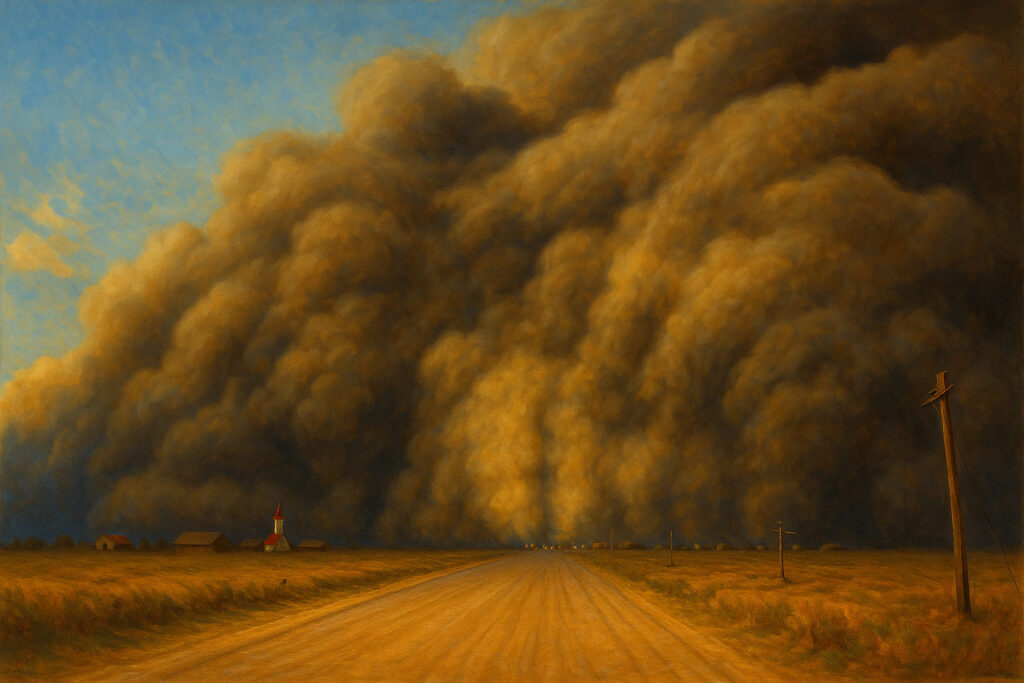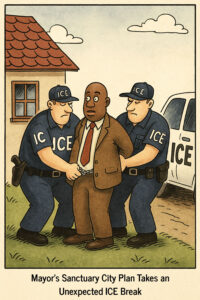 This image is a derivative from “Kodak view of a dusk storm Baca Co., Colorado, Easter Sunday 1935″, Photo by N.R. Stone,” using Sora AI and rendered in the fashion of Norman Rockwell.
This image is a derivative from “Kodak view of a dusk storm Baca Co., Colorado, Easter Sunday 1935″, Photo by N.R. Stone,” using Sora AI and rendered in the fashion of Norman Rockwell.
Easter Sunday, April 14, 1935 — The Day the Sky Turned to Dust
On Easter Sunday, April 14, 1935, residents of Baca County, Colorado, awoke to one of the few calm, warm days they’d experienced in months. For a region devastated by drought and economic ruin, the peaceful morning felt like a reprieve. Families dressed in their Sunday best, attended church, and gathered for modest celebrations. But by afternoon, what looked like a black wall on the horizon brought that peace to an abrupt, terrifying end.
The storm that rolled over Baca County was not an ordinary dust storm. It was one of the most devastating environmental events of the Dust Bowl era—a phenomenon so extreme it became known as “Black Sunday.” The sky darkened unnaturally fast as a massive cold front from Canada stirred up millions of tons of dry topsoil and hurled it across seven states. Winds in excess of 60 miles per hour carried the dust in a towering, rolling wall that swallowed towns whole. Visibility dropped to near zero. The air turned brown, then black. The temperature plunged, and even lamps couldn’t cut through the choking darkness.
One of the most iconic images of that day was taken in Baca County itself: a grainy, stark photograph titled “Kodak view of a dusk storm, Baca Co., Colorado, Easter Sunday 1935,” captured by N.R. Stone. The photo, preserved by the Franklin D. Roosevelt Presidential Library, shows the suffocating wave of dust descending over the plains. It remains one of the most enduring symbols of the Dust Bowl.
That day marked a turning point. Dust storms weren’t new by 1935—farmers and townsfolk across the Great Plains had been dealing with them for years. But Black Sunday was different. The scale was overwhelming, and it struck on a holiday, catching everyone off guard. Some thought the end of the world had come. Others collapsed in fear. Entire communities were paralyzed as the storm passed over them.
The term “Dust Bowl” itself entered popular use after an Associated Press reporter used it while covering the aftermath of the storm. National attention finally turned toward the ecological and human disaster unfolding in the Plains. President Franklin D. Roosevelt’s administration responded by ramping up soil conservation programs and launching New Deal projects to rehabilitate damaged lands. In the weeks following the storm, the Soil Conservation Service was established to promote better farming practices and stem the tide of ecological destruction.
For those who lived through it, Black Sunday left an indelible mark. Some fled west, joining the migration of Dust Bowl refugees. Others stayed and rebuilt. But no one who stood in the path of that storm ever forgot it. In Baca County, what began as a quiet day of hope turned into a descent into darkness—a day when the sky fell down and the land seemed to give up. It was the worst of the Dust Bowl, concentrated into a single, unforgettable storm.
This time period was only great in that it was the time of the great drought—often referred to as the dust bowl—during the Great Depression, certainly not a time that most would want to bring back again.
About “Again”
Each image in this series confronts the myth behind “Make America Great Again.” By adopting Norman Rockwell’s nostalgic style but inserting America’s excluded truths, the series asks: When was it great? For whom? It’s not just a reimagining — it’s a reckoning.
The Past, Reimagined Like Rockwell #14
Is This the “Again?” #8

